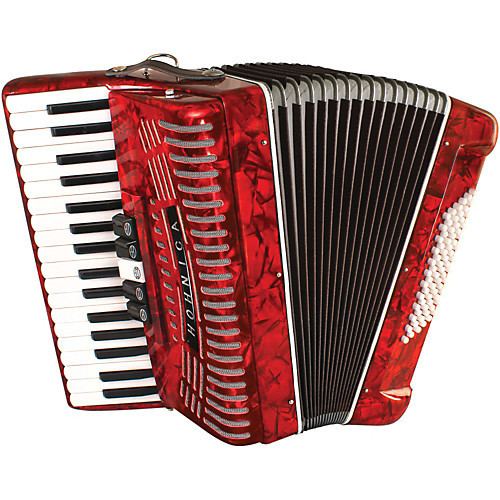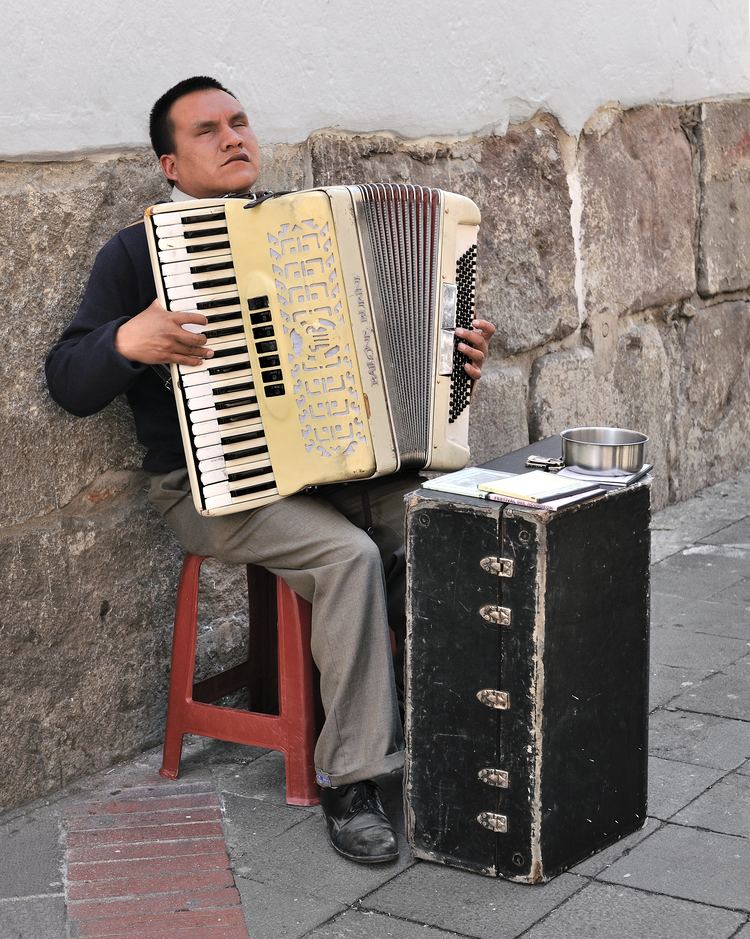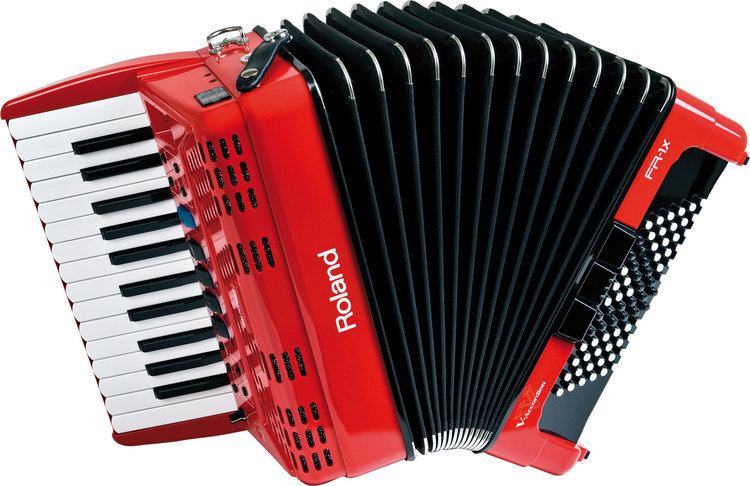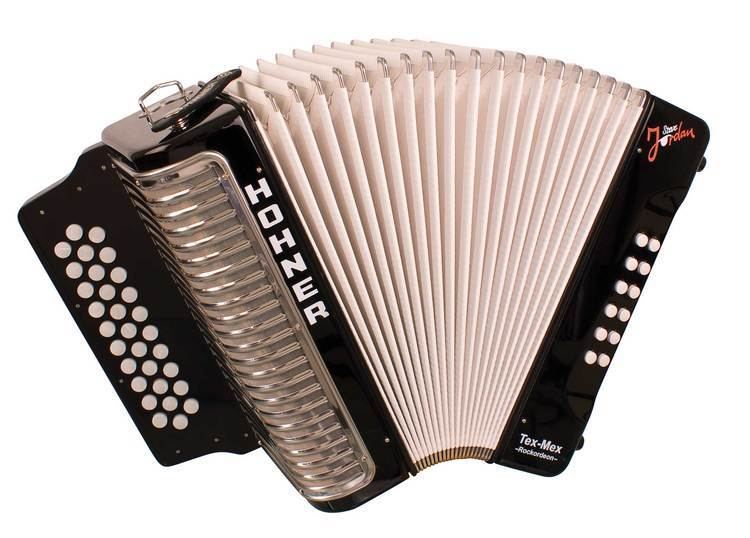Developed Early 19th century Place of origin Europe Classification Keyboard | Instrument family Keyboard Invented Early 1900s | |
 | ||
Accordions (from 19th-century German Akkordeon, from Akkord—"musical chord, concord of sounds") are a family of box-shaped musical instruments of the bellows-driven free-reed aerophone type, colloquially referred to as a squeezebox. A person who plays the accordion is called an accordionist. The concertina and bandoneón are related; the harmonium and American reed organ are in the same family.
Contents
- Construction
- Bellows
- Body
- Pallet mechanism
- Variable components
- Right hand manual systems
- Left hand manual systems
- Reed ranks and switches
- Classification of chromatic and piano type accordions
- Straps
- Unusual accordions
- History
- Use in various music genres
- Use in traditional music
- Use in popular music
- Use in classical music
- Bosnia and Herzegovina
- Brazil
- Colombia
- Mexico
- Use in heavy metal music
- Manufacturing process
- References

The instrument is played by compressing or expanding the bellows while pressing buttons or keys, causing pallets to open, which allow air to flow across strips of brass or steel, called reeds. These vibrate to produce sound inside the body. Valves on opposing reeds of each note are used to make the instrument's reeds sound louder without air leaking from each reed block. The performer normally plays the melody on buttons or keys on the right-hand manual, and the accompaniment, consisting of bass and pre-set chord buttons, on the left-hand manual.

The accordion is widely spread across the world. In some countries (for example Brazil, Colombia and Mexico) it is used in popular music (for example Forró, Sertanejo and B-Pop in Brazil), whereas in other regions (such as Europe, North America and other countries in South America) it tends to be more used for dance-pop and folk music and as well as in regional and is often used in folk music in Europe, North America and South America. Nevertheless, in Europe and North America, some popular music acts also make use of the instrument. Additionally, the accordion is also used in cajun, zydeco, jazz music and in both solo and orchestra performances of classical music. The piano accordion is the official city instrument of San Francisco, California.

The oldest name for this group of instruments is harmonika, from the Greek harmonikos, meaning harmonic, musical. Today, native versions of the name accordion are more common. These names refer to the type of accordion patented by Cyrill Demian, which concerned "automatically coupled chords on the bass side".

Construction

Accordions have many configurations and types. What may be technically possible to do with one accordion could be impossible with another:
Bellows
The bellows is the most recognizable part of the instrument, and the primary means of articulation. Similar to a violin's bow, the production of sound in an accordion is in direct proportion to the motion of the player. The bellows is located between the right- and left-hand manuals, and is made from pleated layers of cloth and cardboard, with added leather and metal. It is used to create pressure and vacuum, driving air across the internal reeds and producing sound by their vibration, applied pressure increasing the volume.
The keyboard touch is not expressive and does not affect dynamics: all expression is effected through the bellows: some bellows effects as illustrated below:
- Bellows used for volume control/fade
- Repeated change of direction ("bellows shake"), which has been popularized by Luiz Gonzaga and is extensively used in Forró and called "resfulengo" in Brazil.
- Constant bellows motion while applying pressure at intervals
- Constant bellows motion to produce clear tones with no resonance
- Using the bellows with the silent air button gives the sound of air moving, which is sometimes used in contemporary compositions particularly for this instrument
Body
The accordion's body consists of two wood boxes joined together by the bellows. These boxes house reed chambers for the right- and left-hand manuals, respectively. Each side has grilles in order to facilitate the transmission of air in and out of the instrument, and to allow the sound to better project. The grille for the right-hand manual is usually larger and is often shaped for decorative purposes. The right-hand manual is normally used for playing the melody and the left-hand manual for playing the accompaniment, however skilled players can reverse these roles.
The size and weight of an accordion varies depending on its type, layout and playing range, which can be as small as to have only one or two rows of basses and a single octave on the right-hand manual, to the standard 120-bass accordion and through to large and heavy 160-bass free-bass converter models.
Pallet mechanism
The accordion is an aerophone. The manual mechanism of the instrument either enables the air flow, or disables it:
Variable components
There is a wide range of instruments that are called accordion. The different types have varying components. All instruments have reed ranks of some format. Not all have switches. The most typical accordion is the piano accordion, which is used for many musical genres. Another type of accordion is the button accordion, which is used in several musical traditions, including Cajun, Conjunto and Tejano music, Swiss and Austro-German Alpine music, Argentinian tango music and many other folk genres.
Right-hand manual systems
Different systems exist for the right-hand manual of an accordion, which is normally used for playing the melody. Some use a button layout arranged in one way or another, while others use a piano-style keyboard. Each system has different claimed benefits by those who prefer it. They are also used to define one accordion or another as a different "type":
Left-hand manual systems
Different systems are also in use for the left-hand manual, which is normally used for playing the accompaniment. These almost always use distinct bass buttons and often have buttons with concavities or studs to help the player navigate the layout despite not being able to see the buttons while playing. There are three general categories:
Reed ranks and switches
Inside the accordion are the reeds that generate the instrument tones. These are organized in different sounding banks, which can be further combined into registers producing differing timbres. All but the smaller accordions are equipped with switches that control which combination of reed banks operate, organized from high to low registers. Each register stop produces a separate sound timbre. See the accordion reed ranks and switches article for further explanation and audio samples.
All but the smallest accordions usually have treble switches. The larger and more expensive accordions often also have bass switches.
Classification of chromatic and piano type accordions
In describing/pricing an accordion, the first factor is size, expressed in number of keys on either side. For a piano type, this could for one example be 37/96, meaning 37 keys (3 octaves plus one note) on the treble side and 96 bass keys. After size, the price and weight of an accordion is largely dependent on the number of reed ranks on either side, either on a cassotto or not, and to a lesser degree on the number of combinations available through register switches. Typically, these could be announced as Reeds: 5 + 3, meaning five reeds on the treble side and three on the bass, and Registers: 13 + M, 7, meaning 13 register buttons on the treble side plus a special "master" that activates all ranks, like the "tutti" on an organ, and seven register switches on the bass side.
Straps
The larger piano and chromatic button accordions are usually heavier than other smaller squeezeboxes, and are equipped with two shoulder straps to make it easier to balance the weight and increase bellows control while sitting, and avoid dropping the instrument while standing.
Other accordions, such as the diatonic button accordion, have only a single shoulder strap and a right hand thumb strap. All accordions have a (mostly adjustable) leather strap on the left-hand manual to keep the player's hand in position while drawing the bellows. There are also straps above and below the bellows to keep it securely closed when the instrument is not playing.
Unusual accordions
Various hybrid accordions have been created between instruments of different buttonboards and actions. Many remain curiosities — only a few have remained in use:
History
The accordion is a free reed instrument and is in the same family as other instruments such as the sheng and khaen. The sheng and khaen are both much older than the accordion and this type of reed did inspire the kind of free reeds in use in the accordion as we know it today.
The accordion's basic form is believed to have been invented in Berlin in 1822 by Christian Friedrich Ludwig Buschmann, although one instrument has been recently discovered that appears to have been built earlier.
The earliest history of the accordion in Russia is poorly documented. Nevertheless, according to Russian researchers, the earliest known simple accordions were made in Tula, Russia by Timofey Vorontsov from 1820, and Ivan Sizov from 1830. By the late 1840s, the instrument was already very widespread; together the factories of the two masters were producing 10,000 instruments a year. By 1866, over 50,000 instruments were being produced yearly by Tula and neighbouring villages, and by 1874 the yearly production rate was over 700,000. By the 1860s, Novgorod, Vyatka and Saratov Governorates also had significant accordion production. By the 1880s, the list included Oryol, Ryazan, Moscow, Tver, Vologda, Kostroma, Nizhny Novgorod, Simbirsk and others, and many of these places created their own varieties of the instrument.
The accordion is one of several European inventions of the early 19th century that used free reeds driven by a bellows. An instrument called accordion was first patented in 1829 by Cyrill Demian, of Armenian origin, in Vienna
Demian's instrument bore little resemblance to modern instruments. It only had a left hand buttonboard, with the right hand simply operating the bellows. One key feature for which Demian sought the patent was the sounding of an entire chord by depressing one key. His instrument also could sound two different chords with the same key; one for each bellows direction (a bisonoric action).
The piano accordion was first played in German-speaking regions, and then spread over Europe. Some early portable instrument with piano keys had been invented in 1821, but it started to actually be played much later, and built its reputation from there.
At that time in Vienna, mouth harmonicas with Kanzellen (chambers) had already been available for many years, along with bigger instruments driven by hand bellows. The diatonic key arrangement was also already in use on mouth-blown instruments. Demian's patent thus covered an accompanying instrument: an accordion played with the left hand, opposite to the way that contemporary chromatic hand harmonicas were played, small and light enough for travelers to take with them and used to accompany singing. The patent also described instruments with both bass and treble sections, although Demian preferred the bass-only instrument owing to its cost and weight advantages.
By 1831 at least the accordion had appeared in Britain. The instrument was noted in The Times of that year as one new to British audiences and not favourably reviewed, but nevertheless it soon became popular. It had also become popular with New Yorkers by the mid-1840s at the latest.
After Demian's invention, other accordions appeared, some featuring only the righthanded keyboard for playing melodies. It took English inventor Charles Wheatstone to squeeze both chords and keyboard together in one squeezebox. His 1844 patent for what he called a “concertina” also featured the ability to easily tune the reeds from the outside with a simple tool.
The musician Adolph Müller described a great variety of instruments in his 1833 book, Schule für Accordion. At the time, Vienna and London had a close musical relationship, with musicians often performing in both cities in the same year, so it is possible that Wheatstone was aware of this type of instrument and may have used them to put his key-arrangement ideas into practice.
Jeune's flutina resembles Wheatstone's concertina in internal construction and tone color, but it appears to complement Demian's accordion functionally. The flutina is a one-sided bisonoric melody-only instrument whose keys are operated with the right hand while the bellows is operated with the left. When the two instruments are combined, the result is quite similar to diatonic button accordions still manufactured today.
Further innovations followed and continue to the present. Various buttonboard and keyboard systems have been developed, as well as voicings (the combination of multiple tones at different octaves), with mechanisms to switch between different voices during performance, and different methods of internal construction to improve tone, stability and durability.
Use in various music genres
The accordion has traditionally been used to perform folk or ethnic music, popular music, and transcriptions from the operatic and light-classical music repertoire. Today the instrument is sometimes heard in contemporary pop styles, such as rock, pop-rock, etc., and occasionally even in serious classical music concerts, as well as advertisements.
Use in traditional music
Invented in 1829, its popularity spread rapidly: it has mostly been associated with the common people, and was spread by Europeans who emigrated around the world. The accordion in both button and piano forms became a favorite of folk musicians and has been integrated into traditional music styles all over the world: see the list of music styles that incorporate the accordion.
Use in popular music
The accordion appeared in popular music from the 1900s to the 1960s. This half-century is often called the "Golden Age of the Accordion". Five players, Pietro Frosini, the two brothers Count Guido Deiro and Pietro Deiro and Slovenian brothers Vilko Ovsenik and Slavko Avsenik, were major influences at this time.
Most vaudeville theaters closed during the Great Depression, but accordionists during the 1930s–1950s taught and performed for radio. During the 1950s through the 1980s the accordion received significant exposure on television with performances by Myron Floren on The Lawrence Welk Show. In the late 1950s and early 1960s, the accordion declined in popularity due to the rise of rock 'n' roll.
In popular music, it is now generally considered exotic or old-fashioned to include the accordion, especially in music for advertisements. Some popular acts do use the instrument in their distinctive sounds. A notable example is Grammy Award winning parodist "Weird Al" Yankovic, who plays the accordion on many of his musical tracks, particularly his polkas. Yankovic was trained in the accordion as a child.
Use in classical music
Although best known as a folk instrument, it has grown in popularity among classical composers. The earliest surviving concert piece is Thême varié très brillant pour accordéon methode Reisner, written in 1836 by Miss Louise Reisner of Paris. Other composers, including the Russian Pyotr Ilyich Tchaikovsky, the Italian Umberto Giordano, and the American Charles Ives (1915), wrote works for the diatonic button accordion.
The first composer to write specifically for the chromatic accordion was Paul Hindemith. In 1922, the Austrian Alban Berg included an accordion in Wozzeck, Op. 7. In 1937 the first Accordion concerto was composed in Russia. Other notable composers have written for the accordion during the first half of the 20th century American composer William P. Perry featured the accordion in his orchestral suite Six Title Themes in Search of a Movie (2008). The experimental composer Howard Skempton began his musical career as an accordionist, and has written numerous solo works for it. In his work Drang (1999), British composer John Palmer has pushed the expressive possibilities of the accordion/bayan to the limits of virtuosity.
French composer Henri Dutilleux used an accordion in both his late song cycles Correspondances (2003) and Le Temps l'Horloge (2009).
Bosnia and Herzegovina
The accordion is a traditional instrument in Bosnia and Herzegovina. It is the dominant instrument used in sevdalinka, a traditional genre of folk music from Bosnia-Herzegovina. It is also considered a national instrument of the country.
Brazil
The accordion is widely used in Brazil, in traditional as well as pop music. Compared to many other countries, the instrument enjoys in Brazil high popularity in mainstream pop music. In some parts of the country, such as the North-East it is the most popular melodic instrument. As opposed to most European folk, a very dry tuning is usually used in Brazil.
The accordion (predominantly the piano accordion) is used in almost all styles of Forró (in particular in the subgenres of Xote and Baião) as principal instrument, Luiz Gonzaga (the King of the Baião) and Dominguinhos being among the notable musicians in this style. In this musical style the typical combination is a trio of accordion, triangle and zabumba (a type of drum). This style has gained popularity recently, in particular among the student population of the South-East of the country (in the Forró Universitário genre, with important exponents today being Falamansa, and trios such as Trio Dona Zefa, Trio Virgulino and Trio Alvorada). Moreover, the accordion is the principal instrument in Junina music (music of the São João Festival), with Mario Zan having been a very important exponent of this music.
It is an important instrument in Sertanejo (and Caipira) music, which originated in the Centre-west and South-east of Brazil and subsequently has gained popularity throughout the country. In the South of the country (where there is a preponderance of the button accordion), in particular in Rio Grande do Sul, it used in the Brazilian Gaúcho musical style, an important exponent of this music being Renato Borghetti.
Colombia
The accordion is also a traditional instrument in Colombia, commonly associated with the vallenato and cumbia genres. The accordion has been used by tropipop musicians such as Carlos Vives, Andrés Cabas, Fonseca (singer) and Bacilos, as well as rock musicians such as Juanes and pop musicians as Shakira. Vallenato, which emerged in the early twentieth century in a city known as Valledupar, has come to symbolize the folk music of Colombia. The legend of the accordion's arrival in Colombia comes from a story of a ship wreck that was coming from Germany to Argentina. The wreck happened over the Magdalena river in the Atlantic coast.
Every year in April, Colombia holds one of the most important musical festivals in the country: the Vallenato Legend Festival. The festival holds contests for best accordion player. Once every decade, the King of Kings accordion competition takes place, when winners of the previous festivals compete for the highest possible award for a vallenato accordion player: the Pilonera Mayor prize. This is the world's largest competitive accordion festival.
Mexico
Norteño heavily relies on the accordion, it is a genre related to polka. Ramón Ayala known in Mexico as the "King of the Accordion" is a norteño musician. Cumbia which features the accordion is also popular with musicians such as Celso Piña creating a more contemporary style.
U.S. born Mexican musician Julieta Venegas incorporates the sound of the instrument into rock, pop and folk. She was influenced by her fellow Chicanos Los Lobos who also use the music of the accordion.
Use in heavy metal music
Accordionists in heavy metal make their most extensive appearances in the folk metal subgenre, and are otherwise generally rare. Full-time accordionists in folk metal seem even rarer, but they are still utilized for studio work, as flexible keyboardists are usually more accessible for live performances.
Notably, the Finnish symphonic folk-metal band Turisas has always had a full-time accordionist, employing classical and polka-style sensibilities alongside a violinist. Another Finnish metal band, Korpiklaani, invokes a type of Finnish polka called humppa, and also has a full-time accordionist. Sarah Kiener, the former hurdy-gurdy player for the Swiss melodic-death/folk metal band Eluveitie, played a Helvetic accordion known as a zugerörgeli, which could be a distant relative (in one way or another) to the Swiss schwyzerörgeli, as both are indigenous to and very rare outside of Switzerland.
Manufacturing process
The best accordions are always fully hand-made, especially in the aspect of reeds; completely hand-made reeds have a far better tonal quality than even the best automatically manufactured reeds. Some accordions have been modified by individuals striving to bring a more pure sound out of low-end instruments, such as the ones improved by Yutaka Usui, a Japanese-born craftsman.
The manufacture of an accordion is only a partly automated process. In a sense, all accordions are handmade, since there is always some hand assembly of the small parts required. The general process involves making the individual parts, assembling the subsections, assembling the entire instrument, and final decorating and packaging.
Famous centres of production are the Italian cities of Stradella and Castelfidardo, with many small and medium size manufacturers especially at the latter. Castelfidardo honours the memory of Paolo Soprani who was one of the first large-scale producers. The French town of Tulle has hosted Maugein Freres since 1919, and the company is now the last complete process manufacturer of accordions in France. Large-scale production existed in Germany by Hohner and Weltmeister, but these lost volume by the end of the 20th century. Hohner still manufactures its top-end models in Germany, whilst the cheaper/student models are made in China; the Weltmeister instruments are still handmade by HARMONA in Klingenthal, Germany.
